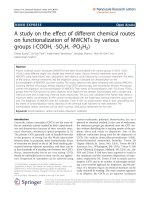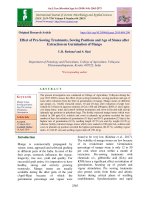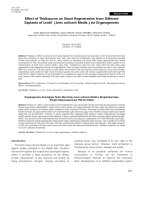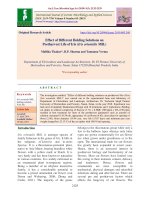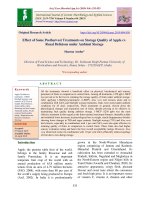Effect of different chemical treatments on germination of strawberry seeds
Bạn đang xem bản rút gọn của tài liệu. Xem và tải ngay bản đầy đủ của tài liệu tại đây (152.07 KB, 5 trang )
Int.J.Curr.Microbiol.App.Sci (2018) 7(3): 1270-1274
International Journal of Current Microbiology and Applied Sciences
ISSN: 2319-7706 Volume 7 Number 03 (2018)
Journal homepage:
Original Research Article
/>
Effect of Different Chemical Treatments on Germination of
Strawberry Seeds
Suman Lata*, Girish Sharma, Sourabh Garg and Munmun Joshi
UAIS Chandigarh University, Gharuan-Mohali, India
Department Fruit Science, Dr Y S Parmar University of Horticulture and Forestry,
Himachal Pradesh-173230, India
*Corresponding author
ABSTRACT
Keywords
Strawberry, Seed
germination, Ethrel,
Gibberellic acid,
H2SO4
Article Info
Accepted:
10 February 2018
Available Online:
10 March 2018
All the chemical treatments resulted in significantly higher strawberry seed
germination over control. Ethrel 5000 ppm recorded highest germination
(86 %) after 30 days of experiment followed by 200 ppm gibberellic acid
(84.33 %) and 1000 ppm ethrel (80.67 %). Least germination (19.0 %) was
observed in control. H2SO4 36N resulted in maximum in vitro strawberry
seed germination and it was statistically at par with H2SO4 30N. Minimum
number of days (2.00) to 50 per cent germination was also recorded with 36
N H2SO4. Maximum number of days (7.00) was taken by the lowest
concentration of H2SO4.
Introduction
Strawberry is a new crop included in the fruit
crop cultivation scenario of HP along with
other temperate fruits as an effective intercrop
and also ensures regular and consistent crop
production and return from sale of both fruits
and runners. With increase in the demand, the
productive fruit cultivars are being evaluated
especially the day-neutral type, which flower
and fruit over a prolonged time period. Further
efforts are being made to introgress the ever
bearing trait to the established cultivars like
Chandler, Gorella, Douglas, Seascape etc. For
any successful crop improvement venture
through breeding programme associated with
genetical studies it is imperative to have
relatively high percentage of seed germination
so that seedling size for growth parameter are
largely similar. Scott and Ink (1955) based on
their study on strawberry seed germination
have pointed out that time of emergence of
strawberry seedlings may vary from 90-140
days in the same lot from the date of seeding.
This has been further proved by Powers
(1945) who showed wide spread variation in
time of seed germination for prolonged time
period even under controlled conditions in
germination chambers. Irregular and delayed
1270
Int.J.Curr.Microbiol.App.Sci (2018) 7(3): 1270-1274
germination is a prime hindrance especially in
soft and small fruits like strawberry,
blueberry, raspberry etc. where uniform
seedling growth is needed otherwise
germination seedling resides total time lag, the
hybrid seedlings being from the same cross
appear to be of different ages, thus hindering
correct assessment of the seedlings. Apart
from this poor seed germination imposes a
serious problem in the improvement of
strawberry through hybridization. With a view
to develop day neutral cultivars, hybrids were
developed and to avoid incorrect assessment
of the hybrid seedling emphasis was laid to
have uniform seed germination. Hence the
present investigation was undertaken in the
Department of Fruit Science, University of
Horticulture and Forestry, Nauni, Solan to
improve the germination of hybrid seeds.
Materials and Methods
Seed from freshly harvested hybrid fruits were
extracted by the usual procedure of separating
the seeds from the pulp by disintegration using
a blender, which was followed by decantation
of the seed. The seeds were further washed
under the tap water to get the seeds free of the
mucilaginous covering over the seed. The
seeds were dried on blotting paper and were
stored at room temperature for 50 days as a
rest period to the seeds for embryo maturation.
The chemicals namely potassium nitrate
(0.2%), ammonium nitrate (0.2 and 0.5 %),
thiourea (500 ppm), gibberellic acid (100 and
200ppm) and ethrel (1000 and 500 ppm)
where used for seed germination, the requisite
information in respect of chemical and the
concentration selected on the basis of
published literature. Before treating the seeds
with selected chemical the hybrid seed was
soaked for 24 hours in distilled water. After
overnight of soaking the seeds 50 in number
were replicated thrice for treating with each
chemical and its selected concentration. The
seeds were treated for 24 hours and control
seeds were treated with distilled water. After
the treatment the seeds were washed with
distil water and were later placed in
petridishes on moist filter paper kept at a room
temperature of 20-22°C. The petridishes were
kept moist by adding few drops of water every
day. Emergence of the radicle was taken as the
criteria of seed germination. The counts of
seed germination were recorded every day and
the ones that germinated were taken out and
planted in a media comprising of soil + sand +
cocopeat.
In second experiment achenes were scarified
under sterile conditions in a vertical laminar
flow hood for 5 minutes with various
concentrations of sulphuric acid (1, 3, 12, 18,
24, 30, and 36N) then rinsed 3 times in sterile
distilled water during 15minutes. They were
then submitted to slow agitation (10 rpm)
during 48 hours insterile distilled water. One
achene per tube (160 x 22 mm) was
germinated on a mineral medium of
Murashige and Skoog (MS) (1962) solidified
with 0.6% (w/v) agar (Difco). The pH of the
medium was adjusted to 5.6 before
autoclaving at 120°C for20 minutes. Tubes
were sealed with a cotton wool plug covered
with a single layer of aluminium foil.
Results and Discussion
The effect of different chemical treatments on
strawberry seed germination is given in Table
1. The observation on germination after 5 days
of treatment showed that seeds treated with
ethrel 5000 ppm had significantly higher
germination (18.67%) per cent followed by
ethrel 1000 ppm (13.00%) and 200 ppm
gibberellic acid (10.33 %). On the other hand
no germination was recorded in the treatments
0.2 and 0.5 per cent ammonium nitrate and
control. Germination per cent with ethrel 1000
(34.51 %) and 5000 ppm (36.00 %) were
statistically at par with each other after 10
days.
Similar
germination
percentage
1271
Int.J.Curr.Microbiol.App.Sci (2018) 7(3): 1270-1274
(30.00%) was recorded with the two
gibberellic acid treatments i.e. at 100 and 200
ppm. The next best treatment was 0.2 per cent
potassium nitrate which had germination up to
26.33 per cent. However only 5 per cent seed
germination was reported with control.
Ethrel5000 ppm showed significantly higher
germination per cent over other treatments
after 15, 20 and 25 days. After 30 days 86 per
cent germination was recorded with 5000 ppm
ethrel followed by 200 ppm gibberellic acid
(84.33 %) and 1000 ppm ethrel (80.67 %).The
treatments 0.2 per cent potassium nitrate and
100 ppm gibberellic acid were statistically
similar. Least germination (19.0 %) was
observed in control.
Table 2 showed the effect of 5 minute
treatment with sulphuric acid onin vitro
strawberry seed germination percentage.
Germination starts from the first week after
sowing for achenes treated by H2SO4 24, 30 or
36N and only during the second week for
those treated with the low concentrations.
Similarly, as the concentration of the acid
increases, the corresponding germination
percentages get higher. Thus, the best
germination percentages were obtained
following treatment with H2SO4 36N and it
was statistically at par with H2SO4 30N.
Minimum germination percentage was
recorded with 3 N H2SO4 (69.67%) and it was
statistically similar with 1N H2SO4 (71.00%).
Minimum number of days (2.00) to 50 per
cent germination was recorded with 36 N
H2SO4. Next lower germination percentage
was recorded with 30N H2SO4 and it was
statistically similar to 24 N H2SO4. Maximum
number of days (7.00) was taken by the lowest
concentration of H2SO4.
Strawberry seeds are generally sown after
stratification though they can germinate
without stratification but the germination
percentage is very low. Direct sowing of the
seeds immediately after extraction from the
fruits give poor germination. Among the
different chemical treatments tried to improve
germination percentage ethrel and gibberellic
acid were found to be most effective in
improving the germination of unstratified
strawberry seeds. The growth regulating
properties of ethrel is known to be due to its
ability to stimulate ethylene production in
plant tissues (Edgerton and Blanpied, 1968).
Stimulation of seed germination and seedling
growth by ethylene treatment has also been
reported in a number of non-dormant seeds
(Balls and Hale, 1940). Iyer et al., (1970)
documented that a 24 hour pre-treatment with
ethrel at concentrations of 1000, 2500 and
5000 ppm gave progressively higher amount
of germination with seeds from ‘Gorella’.
Similarly, Child (1969) investigated the effect
of ethrel on strawberry seed germination.
Soaking the seeds for 24 hour in concentration
of 25,250 and 2500 ppm increase in the
amount and rate of germination were obtained
even with seeds of Axbridge Early which is
known to be normally among the most
difficult to germinate.
Treating the seeds with gibberellic acid seems
to have substituted the after-ripening in
strawberry seeds, giving 84.33 and 70.33 per
cent with 100 and 200 ppm respectively.
Chellappa (1959) reported that seed dormancy
was partially broken in Blakemore, Bremier
and Armore cultivars of strawberry. Negi and
Singh (1972) observed 40-44 per cent
germination of strawberry seeds with
gibberellic acid treatment. After a short period
(18 days) of chilling treatment, gibberellic
acid at 100 ppm promoted significant increase
in germination of Freya and Vigour
(Thompson 1969). Thiourea treatment has also
been reported to be able to affect afterripening in the seeds of peach (Tukey and
Carlson, 1945), grape (Randhawa and Negi,
1964). In the present study potassium nitrate
(0.2%) also significantly (70.67 %) increased
the germination percentage.
1272
Int.J.Curr.Microbiol.App.Sci (2018) 7(3): 1270-1274
Table.1 Effect of different chemicals on strawberry seed germination
Treatment
0.2 %KNO3
0.2%NH4NO3
0.5%NH4NO3
500ppmThiourea
100ppm GA
200ppm GA
1000ppm Ethrel
5000ppm Ethrel
Control
CD at 5%
5 days
6.00
0.00
0.00
4.33
8.00
10.33
13.00
18.67
0.00
0.99
Percentage of seed germination
10 days
15 days
20 days
25 days
26.33
36.33
53.33
66.00
9.67
15.00
22.33
30.33
17.33
26.00
32.33
35.67
18.67
24.67
37.00
42.00
30.00
41.33
55.33
61.00
30.00
47.00
62.00
70.67
34.51
51.67
69.00
76.00
36.00
55.00
76.00
81.33
5.00
10.67
14.00
17.00
1.76
1.79
1.76
1.66
30 days
71.67
38.67
42.00
46.00
71.33
84.33
80.67
86.00
19.00
2.05
Table.2 In vitro germination percentage of strawberry seeds scarified with different
H2SO4 concentrations for 5 minutes
H2SO4 Concentration
1N
3N
12 N
18 N
24 N
30 N
36 N
CD 0.05 %
Final germination after 16
weeks (%)
71.00
69.67
75.33
80.00
86.33
94.00
94.33
1.22
Ammonium nitrate pre-treatment resulted in
44-48 per cent germination (Negi and Singh,
1972). Treatment with ammonium nitrate also
enhances germination over control. In
Agrostis tenuis (Anderson 1946) and mint
(Ikeda and Nakamura 1956) also nitrate ions
have been reported to be effective in breaking
dormancy. Similar results were reported by
Srinivasulu and Murhty (1967) by the use of
these two chemicals.
The effect of the sulphuric acid concentrate
can be explained by the fact that it softens the
teguments making them more permeable to
water and gases, which overcomes the
Time to 50 % of final
germination (weeks)
7.00
5.67
5.00
4.67
3.33
3.00
2.00
0.66
dormancy process and starts the physiological
one of germination. The results are in
agreement with those of Peacock and
Hummer (1996) who studied the effect of
liquid nitrogen and sulphuric acid on the
germination of six species of Rubus. Whereas
the liquid nitrogen treatment did not have a
significant effect on germination percentage
compared to controls, the sulphuric acid
increased significantly this rate within four
species. A 5 minutes scarification with H2SO4
36N gives the best germination percentage.
The longer the achenes are in contact with
sulphuric acid, the more reduced the
germination percentage is; this is undoubtedly
1273
Int.J.Curr.Microbiol.App.Sci (2018) 7(3): 1270-1274
related to the destruction of achenes following
the aggressive treatment.
References
Anderson A M (1946) The effect of light,
temperature and potassium nitrate on
the germination of Agrostis tenuis (var.
High land) seed. Proc. Assoc. Seed
Anal. 36:112-25.
Balls A K and Hale W S (1940). The effect of
ethylene on freshly harvested wheat.
Cereal Chemistry. 17: 490.
Chellapa T (1959). The physiology of
strawberry seed germination. Diss.
Abstr 20:859-60.
Edgerton L J and Blanpied G D (1968)
Regulation of growth and fruit
maturation
with
2-chloroethane
phosphoric acid. Nature 219:1064.
Hamdouni E M EL, Lamarti A and Badoc A
(2001) In virto germination of the
achenes of strawberry (Fragaria x
ananassa Duch.) cvs ‘Chandler’ and
‘Tudla’.
Bull.
Soc.
Pharm.
Bordeaux.140:31-42.
Ikeda N and Nakamura M (1956) Effects of
various treatments on the germination
of mint seeds. Sci Rap Fac Agric
Okavama Univ 9: 39-45.
Iyer C P A, Chacko E K and Subramanyam M
D (1970) Ethrel foe breaking dormancy
of strawberry seeds. Curr. Sci. 39:27172.
Negi S P and Singh R (1972) Effect of
different chemicals on germination of
strawberry seeds. Indian J Hort 29:26568.
Peacock D N, Hummer K E (1996)
Pregermination studies with liquid
nitrogen and sulphuric acid on several
Rubus species. Hort Sci 31 (2):238-39.
Powers L R (1945). Strawberry breeding
studies involving crosses between the
cultivated varieties (Fragaria x
ananassa) and the native Rocky
Mountains
strawberry
(F.ovalis)
J.Agr.Res.70:95-122.
Randhawa G S and S S Negi (1964)
Preliminary studies on seed germination
and seedling growth in grape. Indian J
Hort. 21:186-96.
Scott D H and Ink D P (1955). Treatments to
hasten the emergence of seedlings of
blueberry
and
strawberry.Proc.Am.Soc.Hort.Sci.66:23
7-42.
Srinivasulu K and Murthy K S (1967)
Efficiency of different methods for
breaking dormancy in rice seed. Indian
J Pl. Physiol. 10:139-42.
Thompson P A (1969). The use of chilling
and chemical treatments to promote
rapid germination of strawberry
achenes. J. Hort. Sci. 44:201-10.
Tukey H B and Carlson R F (1945) Breaking
the dormancy of peach seed by
treatment with thiourea. Proc. Amer.
Soc. Hort. Sci. 46:210.
How to cite this article:
Suman Lata, Girish Sharma, Sourabh Garg and Munmun Joshi. 2018. Effect of Different
Chemical Treatments on Germination of Strawberry Seeds. Int.J.Curr.Microbiol.App.Sci.
7(03): 1270-1274. doi: />
1274
